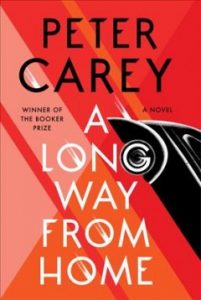As we mentioned in a post a few years ago, beloved patrons, Friday the 13th is a day that plenty of people fear, but no one really seems to know quite why. It might have something to do with the Knights Templar, as Dan Brown and Steve Berry have described in their books. It might be because of Thomas W. Lawson’s 1907 novel Friday, the Thirteenth, in which a stoke broker decides to take advantage of the superstitions regarding the day and create a panic on Wall Street. It’s very much an Anglo-American fear, as Wikipedia notes that other cultures have superstitions regarding Tuesdays, or the 17th day of the month rather than the 13th.
Whatever the case may, we’re pretty sure that today is not going to be wildly different from any other Friday…at least insofar as we have books, and they are good, and they are eager to make your acquaintance. So, without further ago, let’s take a moment to meet some of those brave titles who have trekked on to our shelves this week!

 Unbury Carol: Fans of Josh Malerman’s sensational Bird Box need wait no longer, for his newest work is finally out and on our shelves. This novel is a twisted, dark, and utterly engrossing re-telling of Sleeping Beauty, featuring a heroine named Carol Evers. Carol has died many times . . . but her many deaths are not final: They are comas, a waking slumber indistinguishable from death, each lasting days.Only two people know of Carol’s eerie condition. One is her husband, Dwight, who married Carol for her fortune, and—when she lapses into another coma—plots to seize it by proclaiming her dead and quickly burying her . . . alive. The other is her lost love, the infamous outlaw James Moxie. When word of Carol’s dreadful fate reaches him, Moxie rides the Trail again to save his beloved from an early, unnatural grave. And all the while, awake and aware, Carol fights to free herself from the crippling darkness that binds her—summoning her own fierce will to survive. Brilliantly inventive, hauntingly claustrophobic, and touchingly human, this is another success for Malerman, and will no doubt prove a treat for any fans of his, or Poe, for that matter. Kirkus Reviews noted in its review that “This one haunts you for reasons you can’t quite put your finger on. . . . Malerman is too fierce an original to allow anyone else’s visions to intrude on his. [He] defies categories and comparisons with other writers.”
Unbury Carol: Fans of Josh Malerman’s sensational Bird Box need wait no longer, for his newest work is finally out and on our shelves. This novel is a twisted, dark, and utterly engrossing re-telling of Sleeping Beauty, featuring a heroine named Carol Evers. Carol has died many times . . . but her many deaths are not final: They are comas, a waking slumber indistinguishable from death, each lasting days.Only two people know of Carol’s eerie condition. One is her husband, Dwight, who married Carol for her fortune, and—when she lapses into another coma—plots to seize it by proclaiming her dead and quickly burying her . . . alive. The other is her lost love, the infamous outlaw James Moxie. When word of Carol’s dreadful fate reaches him, Moxie rides the Trail again to save his beloved from an early, unnatural grave. And all the while, awake and aware, Carol fights to free herself from the crippling darkness that binds her—summoning her own fierce will to survive. Brilliantly inventive, hauntingly claustrophobic, and touchingly human, this is another success for Malerman, and will no doubt prove a treat for any fans of his, or Poe, for that matter. Kirkus Reviews noted in its review that “This one haunts you for reasons you can’t quite put your finger on. . . . Malerman is too fierce an original to allow anyone else’s visions to intrude on his. [He] defies categories and comparisons with other writers.”
 Daughters of the Winter Queen: Four Remarkable Sisters, the Crown of Bohemia, and the Enduring Legacy of Mary, Queen of Scots: Nancy Goldstone’s newest history tells the tale of Elizabeth Stuart, granddaughter of Mary, Queen of Scots, and her four daughters. When her godmother, Queen Elizabeth I, died and her father, James I, ascended to the illustrious throne of England, Elizabeth Stuart assumed a life of wealth and privilege that might surprise many even today. At sixteen she was married to a dashing German count far below her rank, with the understanding that James would help her husband achieve the crown of Bohemia. Her father’s terrible betrayal of this promise would ruin “the Winter Queen,” as Elizabeth would forever be known, imperil the lives of those she loved, and launch a war that would last for thirty years. Forced into exile, the Winter Queen and her growing family found refuge in Holland, where the glorious art and culture of the Dutch Golden Age formed the backdrop to her daughters’ education. The eldest, Princess Elizabeth, was renowned as a scholar when women were all but excluded from serious study and counted the preeminent philosopher René Descartes among her closest friends. Louise Hollandine, whose lively manner and appealing looks would provoke heartache and scandal, was a gifted painter. Shy, gentle Henrietta Maria, the beauty of the family, would achieve the dynastic ambition of marrying into royalty, although at great cost. But it would be the youngest, Sophia, a heroine in the tradition of Jane Austen, whose ready wit and good-natured common sense masked immense strength of character, who would fulfill the promise of her great-grandmother, a legacy that endures to this day. Goldstone is a historian who is able to capture not only dates and trends, but to color in the details of individuals, to emphasize their successes and flaws so well that you’ll feel as if you’ve spent time with royalty after reading this book. Fans of The Crown, as well as history buffs of all stripes will love this book, which earned a starred review from Library Journal, which called it “A compulsively readable account of an otherwise unfamiliar royal family. Goldstone writes with knowledge, humor, and ease–a masterly storyteller who steers clear of overly academic language. Ideal for amateur Tudor historians who wish to be introduced to a lesser-known yet equally fascinating royal family.”
Daughters of the Winter Queen: Four Remarkable Sisters, the Crown of Bohemia, and the Enduring Legacy of Mary, Queen of Scots: Nancy Goldstone’s newest history tells the tale of Elizabeth Stuart, granddaughter of Mary, Queen of Scots, and her four daughters. When her godmother, Queen Elizabeth I, died and her father, James I, ascended to the illustrious throne of England, Elizabeth Stuart assumed a life of wealth and privilege that might surprise many even today. At sixteen she was married to a dashing German count far below her rank, with the understanding that James would help her husband achieve the crown of Bohemia. Her father’s terrible betrayal of this promise would ruin “the Winter Queen,” as Elizabeth would forever be known, imperil the lives of those she loved, and launch a war that would last for thirty years. Forced into exile, the Winter Queen and her growing family found refuge in Holland, where the glorious art and culture of the Dutch Golden Age formed the backdrop to her daughters’ education. The eldest, Princess Elizabeth, was renowned as a scholar when women were all but excluded from serious study and counted the preeminent philosopher René Descartes among her closest friends. Louise Hollandine, whose lively manner and appealing looks would provoke heartache and scandal, was a gifted painter. Shy, gentle Henrietta Maria, the beauty of the family, would achieve the dynastic ambition of marrying into royalty, although at great cost. But it would be the youngest, Sophia, a heroine in the tradition of Jane Austen, whose ready wit and good-natured common sense masked immense strength of character, who would fulfill the promise of her great-grandmother, a legacy that endures to this day. Goldstone is a historian who is able to capture not only dates and trends, but to color in the details of individuals, to emphasize their successes and flaws so well that you’ll feel as if you’ve spent time with royalty after reading this book. Fans of The Crown, as well as history buffs of all stripes will love this book, which earned a starred review from Library Journal, which called it “A compulsively readable account of an otherwise unfamiliar royal family. Goldstone writes with knowledge, humor, and ease–a masterly storyteller who steers clear of overly academic language. Ideal for amateur Tudor historians who wish to be introduced to a lesser-known yet equally fascinating royal family.”
 Ritz and Escoffier: The Hotelier, the Chef, and the Rise of the Leisure Class: In early August 1889, César Ritz, a Swiss hotelier highly regarded for his exquisite taste, found himself at the Savoy Hotel in London. He had come at the request of Richard D’Oyly Carte, the financier of Gilbert & Sullivan’s comic operas, who had modernized theater and was now looking to create the world’s best hotel. D’Oyly Carte soon seduced Ritz to move to London with his team, which included Auguste Escoffier, the chef de cuisine known for his elevated, original dishes. The result was a hotel and restaurant like no one had ever experienced, run in often mysterious and always extravagant ways–which created quite a scandal once exposed. In a tale replete with scandal and opulence, Luke Barr transports readers to turn-of-the-century London and Paris to discover how celebrated hotelier César Ritz and famed chef Auguste Escoffier joined forces at the Savoy Hotel to spawn the modern luxury hotel and restaurant industry. Booklist loved this energetic and illuminating book, calling it “[A] lively, gossipy account . . . not just a fluidly structured dual biography, but a provocative history of a turning point in the evolving hotel and restaurant industry.”
Ritz and Escoffier: The Hotelier, the Chef, and the Rise of the Leisure Class: In early August 1889, César Ritz, a Swiss hotelier highly regarded for his exquisite taste, found himself at the Savoy Hotel in London. He had come at the request of Richard D’Oyly Carte, the financier of Gilbert & Sullivan’s comic operas, who had modernized theater and was now looking to create the world’s best hotel. D’Oyly Carte soon seduced Ritz to move to London with his team, which included Auguste Escoffier, the chef de cuisine known for his elevated, original dishes. The result was a hotel and restaurant like no one had ever experienced, run in often mysterious and always extravagant ways–which created quite a scandal once exposed. In a tale replete with scandal and opulence, Luke Barr transports readers to turn-of-the-century London and Paris to discover how celebrated hotelier César Ritz and famed chef Auguste Escoffier joined forces at the Savoy Hotel to spawn the modern luxury hotel and restaurant industry. Booklist loved this energetic and illuminating book, calling it “[A] lively, gossipy account . . . not just a fluidly structured dual biography, but a provocative history of a turning point in the evolving hotel and restaurant industry.”
 A Long Way From Home: Two-time-Booker-Prize-winner Peter Carey is back with a book in which he confronts head-on his native Australia’s history of race and racism, all while capturing the beauty, zaniness, and audacity of its infamous 10,000-mile race, the Redex Trial. Irene Bobs loves fast driving. Her husband is the best car salesman in southeastern Australia. Together they enter the Redex Trial, a brutal race around the ancient continent, over roads no car will ever quite survive. With them is their lanky, fair-haired navigator, Willie Bachhuber, a quiz show champion and failed schoolteacher who calls the turns and creeks crossings on a map that will remove them, without warning, from the white Australia they all know so well and into the heart of a country that is utterly unfamiliar to them–and yet one to which they are inextricably, and inexorably, bound. As with so many of his best works, Carey uses comedy to soften some his fiercest punches, but doesn’t let the jokes get in the way of the deepest meanings of his books. Many have agreed this is his best novel in decades (if not his best work, period), and Kirkus Reviews, who gave this work a starred review, said, “This picaresque comedy goes thematically deeper as it heads into the Outback… The comic spirit slyly suggests Shakespeare, an inquiry into identity and the farcical human existence. . . . Carey’s novel raises issues of culture and race that carry a thoroughly contemporary charge.”
A Long Way From Home: Two-time-Booker-Prize-winner Peter Carey is back with a book in which he confronts head-on his native Australia’s history of race and racism, all while capturing the beauty, zaniness, and audacity of its infamous 10,000-mile race, the Redex Trial. Irene Bobs loves fast driving. Her husband is the best car salesman in southeastern Australia. Together they enter the Redex Trial, a brutal race around the ancient continent, over roads no car will ever quite survive. With them is their lanky, fair-haired navigator, Willie Bachhuber, a quiz show champion and failed schoolteacher who calls the turns and creeks crossings on a map that will remove them, without warning, from the white Australia they all know so well and into the heart of a country that is utterly unfamiliar to them–and yet one to which they are inextricably, and inexorably, bound. As with so many of his best works, Carey uses comedy to soften some his fiercest punches, but doesn’t let the jokes get in the way of the deepest meanings of his books. Many have agreed this is his best novel in decades (if not his best work, period), and Kirkus Reviews, who gave this work a starred review, said, “This picaresque comedy goes thematically deeper as it heads into the Outback… The comic spirit slyly suggests Shakespeare, an inquiry into identity and the farcical human existence. . . . Carey’s novel raises issues of culture and race that carry a thoroughly contemporary charge.”
 A Necessary Evil: Readers who enjoyed Abir Mukherjee’s first mystery featuring Captain Wyndham and Sergeant Banerjee of the Calcutta Police Force will delight in their return in this second complex, historically detailed, and polished mystery. The fabulously wealthy kingdom of Sambalpore is home to tigers, elephants, diamond mines, and the beautiful Palace of the Sun. But when the heir to the throne is assassinated in the presence of Captain Sam Wyndham and Sergeant ‘Surrender-Not’ Banerjee, they discover a kingdom riven with suppressed conflict. Prince Adhir was a modernizer whose attitudes―and romantic relationships―may have upset the more religious elements of his country, while his brother―now in line to the throne―appears to be a feckless playboy. As Wyndham and Banerjee desperately try to unravel the mystery behind the assassination, they become entangled in a dangerous world where those in power live by their own rules―and those who cross their paths pay with their lives. They must find a murderer, before the murderer finds them. Publisher’s Weekly gave this second entry into a sensational series a starred review, calling it “Impressive. This successful evocation of the Raj in the service of a brilliant whodunit demonstrates that Mukherjee’s debut was no fluke.”’
A Necessary Evil: Readers who enjoyed Abir Mukherjee’s first mystery featuring Captain Wyndham and Sergeant Banerjee of the Calcutta Police Force will delight in their return in this second complex, historically detailed, and polished mystery. The fabulously wealthy kingdom of Sambalpore is home to tigers, elephants, diamond mines, and the beautiful Palace of the Sun. But when the heir to the throne is assassinated in the presence of Captain Sam Wyndham and Sergeant ‘Surrender-Not’ Banerjee, they discover a kingdom riven with suppressed conflict. Prince Adhir was a modernizer whose attitudes―and romantic relationships―may have upset the more religious elements of his country, while his brother―now in line to the throne―appears to be a feckless playboy. As Wyndham and Banerjee desperately try to unravel the mystery behind the assassination, they become entangled in a dangerous world where those in power live by their own rules―and those who cross their paths pay with their lives. They must find a murderer, before the murderer finds them. Publisher’s Weekly gave this second entry into a sensational series a starred review, calling it “Impressive. This successful evocation of the Raj in the service of a brilliant whodunit demonstrates that Mukherjee’s debut was no fluke.”’
Until next week, beloved patrons–happy reading!
